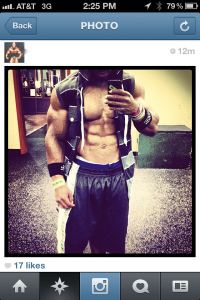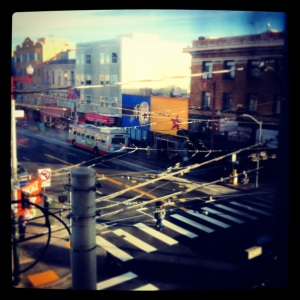Finally, the big pharmaceutical companies have gotten together and developed a drug to treat the common anti-mainstream trends that ail us.
Tag Archives: instagram
#Instafit: body building culture comes to Instragram
 Over the last few months that I’ve been slowly falling in love with the social photo sharing site Instagram. It’s a simple little mobile application that allows you to take, edit, and share photos with your friends and the larger Instagram community. Interestingly there are actually several applications that allow you to take photos and apply filters to make your pictures look pretty, but only Instagram has gotten the social aspect right. (Examples of other applications include: Hipstamatic, PhotoShop Express, and Camera by SmugMug.)
Over the last few months that I’ve been slowly falling in love with the social photo sharing site Instagram. It’s a simple little mobile application that allows you to take, edit, and share photos with your friends and the larger Instagram community. Interestingly there are actually several applications that allow you to take photos and apply filters to make your pictures look pretty, but only Instagram has gotten the social aspect right. (Examples of other applications include: Hipstamatic, PhotoShop Express, and Camera by SmugMug.)
Never mind that Instagram doesn’t necessarily have the best filters to be applied to doctor up their photos, it’s the social element that has made it a big success. Instagram intrigues people with the process of discovering new photos and users, as well as the excitement and validation from receiving multiple likes on your photos. From art to nature photos, from travel to food porn, and from pictures of couples and friends – Instagram has it all. Of all these areas to discover, one trend has certainly caught my eye: the body building community.
 The body building community has been around for a long time (at least since the 1970’s in the U.S.), but the rise of social networks and body-building forums have allowed this dispersed community of bodybuilders to come together virtually. They trade advice on workout routines and nutritional supplements in body building forums, as well as complement and comment on each other’s progress on weightlifting goals by posting pictures in common sites. With the advent of Instagram its become that much easier for these folks to find, comment, and follow each other. These bodybuilders comment on each other’s pictures with encouragement like: “great pic! Keep posting!”, “sick abs, great job man”, “what’s your workout routine like, have any
The body building community has been around for a long time (at least since the 1970’s in the U.S.), but the rise of social networks and body-building forums have allowed this dispersed community of bodybuilders to come together virtually. They trade advice on workout routines and nutritional supplements in body building forums, as well as complement and comment on each other’s progress on weightlifting goals by posting pictures in common sites. With the advent of Instagram its become that much easier for these folks to find, comment, and follow each other. These bodybuilders comment on each other’s pictures with encouragement like: “great pic! Keep posting!”, “sick abs, great job man”, “what’s your workout routine like, have any  tips?” and some that become a little more directly sexual like “U are gorgeous”, “I think U so sexy”, and “take off the pants & underwearrr”. The funny thing about this is that many of these body builders, who are purportedly heterosexual, receive just as many of these comments from girls as they do from guys. They write in their personal bios: “just me tryna get big”, “shrugs not drugs”, “fitness and music keep me young”, “forever young”, “follow me on twitter”, “add me on kik”.
tips?” and some that become a little more directly sexual like “U are gorgeous”, “I think U so sexy”, and “take off the pants & underwearrr”. The funny thing about this is that many of these body builders, who are purportedly heterosexual, receive just as many of these comments from girls as they do from guys. They write in their personal bios: “just me tryna get big”, “shrugs not drugs”, “fitness and music keep me young”, “forever young”, “follow me on twitter”, “add me on kik”.
There are also a few super users making a name for themselves by re-sharing other bodybuilders’ photos and then encouraging their followers to like and follow the featured body builder of the day. Examples of these include “Ru ffRoad”, “CuteBoys” and “HotGuysWorld”. (They may be walking a fine line of ethical & legal rules because it seems some of them get taken down from time to time.) Many users use hashtags (#) in the descriptions of their photos to tag their photo as discoverable for a certain theme. Bodybuilders are not the humble sort, but rather into self promotion using tags like: “#model, #sexy, #sixpack, #hottie, #muscle, #picoftheday, #stunning, #adorable, #instaboys, and #instafit.
ffRoad”, “CuteBoys” and “HotGuysWorld”. (They may be walking a fine line of ethical & legal rules because it seems some of them get taken down from time to time.) Many users use hashtags (#) in the descriptions of their photos to tag their photo as discoverable for a certain theme. Bodybuilders are not the humble sort, but rather into self promotion using tags like: “#model, #sexy, #sixpack, #hottie, #muscle, #picoftheday, #stunning, #adorable, #instaboys, and #instafit.
Most of this is all fine and good. However there are certainly some troublesome things brewing in here. First of all there is the very likely possibility that many of the pictures being shared and re-shared are of underage youth (below 18 years old) and their pictures are being consumed and sexualized by adults. Second, many young adults and teenagers are now becoming part of this hyper-sexualized and steroid enhancing world – which is putting them at risk. The kid in this last photo here definitely looks barely 18. The NY Times had a nice article on this a while back: http://www.nytimes.com/2012/11/19/health/teenage-boys-worried-about-body-image-take-risks.html?pagewanted=all&_r=0
And since this website starting as a hipster-bashing blog I feel that I should mention my college friend’s site: http://definitionhipster.com/ and Instagram handle: DEFINITIONHIPSTER. His we bsite allows people to submit pictures of people and then vote on on a scale of 1 to 10 on how hipster they look in the photo.
bsite allows people to submit pictures of people and then vote on on a scale of 1 to 10 on how hipster they look in the photo.
You can also follow my Instagram: MISSIONHIPSTERS. I apologize in advance if you got to my profile hoping to find shirtless pictures of dudes, sorry you won’t find any there.
The Hipsterification of America
In case you haven’t heard, hipsters are everywhere. As this NPR article points out – in some ways its cooler to be a hipster in a small city than in a bigger, more well known city. So you live in Williamsburg, NYC? Well, my friend, that has so been done already.
http://www.npr.org/2011/11/16/142387490/the-hipsterfication-of-america?sc=17&f=1001
The Hipsterfication Of America
by Linton Weeks
The hotel lobby in Franklin, Tenn., has an ultra-urban loft-esque feel — exposed air ducts, austere furniture and fixtures, music videos projected onto a flat panel. Everywhere there is lava-lampish aqua and amber lighting.
Sale racks near the front desk display chargers for iPods and BlackBerrys and a variety of snacks, including Cocoa Puffs and Red Bulls. Every room features a media box for digital video and music.
Welcome to Aloft, a hipster hotel on the outskirts of Nashville.
Nearby are Plato’s Closet, a recycled-clothing store where hipsters shop, and Which Wich, a sandwich shop — touting its “edgy, magnetic environment” — where hipsters eat.
On the streets of Franklin and Nashville and almost every town throughout America now, hipsters scuttle by on scooters, zip around in Zipcars or Smart cars, roll by on fixed-gear bikes or walk about in snazzy high-top sneakers and longboard shorts. They snap Instagram photos of each other — in black skinny jeans and T-shirts with funky epigrams like “If You Deny It, You Are A Hipster” — and turn the pix into iPhone cases. They buy cool-cat snuggle clothes at American Eagle and down-market monkey boots at Urban Outfitters. They drink cheap beer, listen to music on vinyl records and decorate their lairs with upcycled furniture.
What’s funny is that people who aren’t hipsters generally express distaste for them and those who appear to be hipsters hate to be identified as such. Everybody hates hipsters … especially hipsters. – Peter Furia
They follow indie bands and camp out at Occupy movements. They work as programmers and shop clerks, baristas and bartenders. They are gamers and volunteers, savvy entrepreneurs and out-of-work basement dwellers.
In case you haven’t noticed, hipsters — and those who cater to them — are everywhere. And that really galls some hipsters.
The Ironic Hipster
“Hipster culture is omnipresent,” says Peter Furia, a founder of Seedwell Digital Creative Studio in San Francisco. “It dominates fashion, music and lifestyle. It crosses borders of ethnicity, socio-economic status and sexual preference — something that we haven’t seen since the boom of hip-hop culture.”
Furia’s studio is producing a documentary-style Web series, American Hipster — for its nascent YouTube channel — that will debut in April 2012. “What’s funny is that people who aren’t hipsters generally express distaste for them and those who appear to be hipsters hate to be identified as such. Everybody hates hipsters … especially hipsters. And the ironic part is that hipsters’ opposition to pop culture has become pop culture.”
You might think that as hipsterism ripples out, in concentric (and eccentric) circles farther and farther from its big-city epicenters, the ultra-coolitude would lose its authenticity, Furia says, “but the opposite may be true. Cities are known for setting trends; hipsterism is about anti-trends. It sounds funny, but hipsters in Omaha may actually be cooler than hipsters in New York City — everyone knows about New York City.”

American society, Furia says, often thinks of hipsters as “posers who appropriate an image of cool individuality but lack authenticity, but we think there may be real substance beneath it all.”
He points to social waves such as urban farming, the Do It Yourself initiatives and the Occupy movement. “There are lots of hipsters in all of these movements,” he says, “who are authentic in their passions.”
Revenge Of The Hipster
To many the American hipster represents more than ironic graphic T’s and gourmet grilled cheese sandwiches. “I like to believe there’s something smarter lurking within our romance with hip … an idea of enlightenment and awareness,” says John Leland, a New York Times reporter and author of the 2004 book Hip: The History.
America does have a long love affair with being hip — not only up to date and au courant, but ahead of the curve. The Urban Dictionary defines hipsters as “a subculture of men and women typically in their 20s and 30s who value independent thinking, counter-culture, progressive politics, an appreciation of art and indie-rock, creativity, intelligence, and witty banter.”
The greatest concentrations of hipsters, the hiptionary definition continues, “can be found living in the Williamsburg, Wicker Park and Mission District neighborhoods of major cosmopolitan centers such as New York, Chicago, and San Francisco respectively.”
Sure enough, just a couple of years ago everyone was writing about discrete hipster enclaves. A 2009 essay in Time magazine focused on the Brooklyn neighborhood of Williamsburg, noting that because of a lagging economy and neighborhood gentrification, “Hipsterdom’s largest natural habitat, it seems, is under threat.”
But in fact, the opposite happened. In the past couple of years, Hipsterdom has entered — and in some cases, dominated — dominant culture. Hipsters, after all, know how to adapt: how to make the cheap chic, the disheveled dishy, the peripheral preferable. A shaky, shabby economy is the perfect breeding ground for hipsters.
A New Hipsterdom
Modern historians trace the term “hip” at least back to the Jazz Age. The word’s origins are in dispute. Some believe it came from “hop,” a street word for opium; or the hip flask carried by clandestine drinkers, or “hepi,” an African word meaning “open-eyed awareness.”
The hipster’s ancestry no doubt involves hepcats and beatniks and hippies. Today some hipsters are so hip they refuse to use the word self-referentially and believe that anyone who does so is, well, hip-o-critical.
As long as hipsters were confined to cool urban corrals, they were easy to deride. Robert Lanham’s 2003 The Hipster Handbook poked fun at them. A hipster, he wrote, is someone who has one Republican friend whom the hipster always describes as his “one Republican friend.”

But with the hipsterfication of America, today’s hipsters come in all stripes and all political persuasions. Rachel Maddow and S.E. Cupp to courtesy phones, please.
And all ages: Not everyone who is hip is young, and not everyone who is young is hip. Hipsterishness is a state of mind.
We are seeing the dawn of a new hipsterdom. The subculture has become an omniculture and its denizens can be found outside Nashville and in Grinnell, Iowa, and in Omaha, Neb. Visit the Little River Coffee Bar in Spartanburg, S.C., the Busted Lift in Dubuque, Iowa, or the Bikini Lounge in Phoenix.
And hipsterfication is happening at hyperspeed. “Hip used to have a lag time,” the Times‘ Leland explains. “Weirdos and creative people fled their intolerant small town for the city, where they could be anonymous and find other weirdos. Together they combined their knowledge — of style or wisdom, of outsider lore, black and white — to produce hip.”
The expression of hipness, Leland says, “had to be private to be distinct, understood only by the inner circle.”
Eventually the hip sensibility was adopted by bigger and bigger circles until it boomeranged back to the small towns, Leland says. “Now there’s no lag time. Those syntheses and exchanges take place not in physical spaces but metaphorical ones — in cyberspace, in the marketplace, in the media. So stuff that looks like hip is everywhere.”
